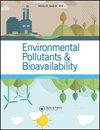Potentiometric studies on the formation equilibria of ternary complexes of vanadium(III) with cysteine and some amino acids
Q3 Chemical Engineering
引用次数: 2
Abstract
In this work, we present the results of the speciation of the ternary vanadium(III)–cysteine (H2Cys) complexes with the amino acids glycine (HGly), proline (HPro), α-alanine (HαAla), β-alanine (HβAla), histidine (HHis), aspartic acid (H2Asp), and glutamic acid (H2Glu), studied by the measurements of electromotive forces, emf(H), using 3.0 mol dm−3 KCl as the ionic medium at 25 °C. The experimental data were analyzed by means of the computational least-squares program LETAGROP, taking into account the hydrolysis of the vanadium(III) cation, the respective stability constants of the binary complexes, and the acid base reactions of the amino acids, which were kept fixed during the analysis. In the vanadium(III)–cysteine-amino acid (HB) systems, where HB represents the bidentate ligands, the formations of the ternary complexes [V(Cys)(HB)]+, V(Cys)(B), [V(Cys)(B)(OH)]−, and [V(Cys)(B)(OH)2]2− were observed. In the vanadium(III)-H2Cys-HHis system, the formations of the complexes [V(HCys)(HHis)]2+, [V(HCys)(His)]+, V(Cys)(His), and [V(Cys)(His)(OH)]− were detected; in the vanadium(III)-H2Cys-H2Asp system, the complexes [V(H2Cys)(HAsp)]2+, [V(HCys)(HAsp)]+, V(HCys)(Asp), [V(Cys)(Asp)]−,and [V(Cys)(Asp)(OH)]2− were detected; and finally, in the vanadium(III)-H2Cys-H2Glu system, the complexes [V(H2Cys)(HGlu)]2+, [V(HCys)(HGlu)]+, V(Cys)(HGlu), and [V(Cys)(HGlu)(OH)]− were observed. The species distribution diagrams as a function of pH are briefly discussed.钒(III)与半胱氨酸和某些氨基酸三元配合物形成平衡的电位法研究
在这项工作中,我们提出了钒(III) -半胱氨酸(H2Cys)三元配合物与氨基酸甘氨酸(HGly),脯氨酸(HPro), α-丙氨酸(Hα ala), β-丙氨酸(Hβ ala),组氨酸(HHis),天冬氨酸(H2Asp),谷氨酸(H2Glu),电动势(H)的测量结果,在25℃下,使用3.0 mol dm−3 KCl作为离子介质,研究了电动势(H)的形成。采用LETAGROP计算最小二乘程序对实验数据进行分析,考虑了钒(III)阳离子的水解、二元配合物各自的稳定常数和氨基酸的酸碱反应,在分析过程中保持固定。在钒(III) -半胱氨酸-氨基酸(HB)体系中,HB代表双齿配体,观察到三元配合物[V(Cys)(HB)]+、V(Cys)(B)、[V(Cys)(B)(OH)]−和[V(Cys)(B)(OH)2]2−的形成。在钒(III)-H2Cys-HHis体系中,检测到络合物[V(HCys)(HHis)]2+、[V(HCys)(His)]+、V(Cys)(His)和[V(Cys)(His)(OH)]−的形成;在钒(III)-H2Cys-H2Asp体系中,检测到配合物[V(H2Cys)(HAsp)]2+、[V(HCys)(HAsp)]+、V(HCys)(Asp)、[V(Cys)(Asp)]−和[V(Cys)(Asp)(OH)]2−;最后,在钒(III)-H2Cys-H2Glu体系中,观察到配合物[V(H2Cys)(HGlu)]2+、[V(HCys)(HGlu)]+、V(Cys)(HGlu)和[V(Cys)(HGlu)(OH)]−。简要讨论了随pH值变化的物种分布图。
本文章由计算机程序翻译,如有差异,请以英文原文为准。
求助全文
约1分钟内获得全文
求助全文
来源期刊
CiteScore
1.62
自引率
0.00%
发文量
0
审稿时长
1 months
期刊介绍:
Chemical Speciation & Bioavailability ( CS&B) is a scholarly, peer-reviewed forum for insights on the chemical aspects of occurrence, distribution, transport, transformation, transfer, fate, and effects of substances in the environment and biota, and their impacts on the uptake of the substances by living organisms. Substances of interests include both beneficial and toxic ones, especially nutrients, heavy metals, persistent organic pollutants, and emerging contaminants, such as engineered nanomaterials, as well as pharmaceuticals and personal-care products as pollutants. It is the aim of this Journal to develop an international community of experienced colleagues to promote the research, discussion, review, and spread of information on chemical speciation and bioavailability, which is a topic of interest to researchers in many disciplines, including environmental, chemical, biological, food, medical, toxicology, and health sciences.
Key themes in the scope of the Journal include, but are not limited to, the following “6Ms”:
Methods for speciation analysis and the evaluation of bioavailability, especially the development, validation, and application of novel methods and techniques.
Media that sustain the processes of release, distribution, transformation, and transfer of chemical speciation; of particular interest are emerging contaminants, such as engineered nanomaterials, pharmaceuticals, and personal-care products.
Mobility of substance species in environment and biota, either spatially or temporally.
Matters that influence the chemical speciation and bioavailability, mainly environmentally relevant conditions.
Mechanisms that govern the transport, transformation, transfer, and fate of chemical speciation in the environment, and the biouptake of substances.
Models for the simulation of chemical speciation and bioavailability, and for the prediction of toxicity.
Chemical Speciation & Bioavailability is a fully open access journal. This means all submitted articles will, if accepted, be available for anyone to read, anywhere, at any time. immediately on publication. There are no charges for submission to this journal.

 求助内容:
求助内容: 应助结果提醒方式:
应助结果提醒方式:


